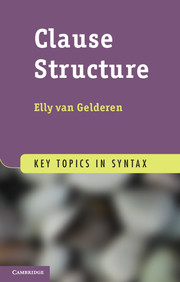5 - The CP-Layer
Published online by Cambridge University Press: 05 June 2013
Summary
After looking at the thematic layer in Chapter 3 and the grammatical layer in Chapter 4, we reach the last and highest layer, the pragmatic one. This is the layer that looks “outside” the clause. If the CP is a main clause, its C indicates the mood (indicative, interrogative, imperative, etc.); finiteness, and the topic and focus are all part of the expanded CP. If the CP is an embedded clause, it links itself to another clause by means of a complementizer, and hence the name Complementizer Phrase. Embedded CPs are typically less expanded and also are subject to much cross-linguistic variation. English is actually rather restricted in its use of the matrix CP for topic and focus.
In Section 5.1, I first provide some background on the history of the CP before going into the expanded CP. Section 5.2 looks at complementizers, and Section 5.3 at mood and CP adverbials that are also candidates for inclusion in this layer. Section 5.4 provides evidence for topic and focus positions as part of the CP-Layer, and Section 5.5 provides some cross-linguistic observations. As in the case of the TP-Layer, the chapter argues that languages differ in the categories that are included in this layer. It also provides an alternative to the strict Cartographic approach, suggesting there is a requirement of pragmatic interpretation at the C-I interface.
- Type
- Chapter
- Information
- Clause Structure , pp. 150 - 188Publisher: Cambridge University PressPrint publication year: 2013

